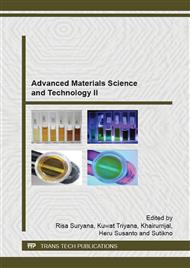p.3
p.7
p.12
p.16
p.20
p.24
p.27
p.31
p.35
Optimization of Solvent System and Polymer Concentration for Synthesis of Polyvinyl Alcohol (PVA) Fiber Using Rotary Forcespinning Technique
Abstract:
Rotary forcespinning is one of techniques used for fabrication of polymer fiber. In this paper optimization of several parameters for synthesis of Polyvinyl Alcohol (PVA) fiber using rotary forcespinning technique was described. In order to obtain PVA fiber with smallest diameter the optimization parameters of solvent system and polymer concentration were performed. The results show that PVA dissolved in water as a single solvent produced fiber with high wettability. A mixture of water and ethanol as a solvent system was developed with variation in ethanol content. The effects of ethanol content on fiber diameter were investigated. Rotary forcespinning using solvent with ethanol content below 30% resulted in PVA fiber with high wettability, while solvent ethanol content of more than 70% was unable to dissolve PVA completely. The effect of PVA concentration on the fiber morphology was investigated by adjusting PVA concentration in the range of 9 to 13 weight %. The diameter of the PVA fiber was uniform and could be controlled by adjusting the PVA concentration.
Info:
Periodical:
Pages:
20-23
Citation:
Online since:
August 2015
Keywords:
Price:
Сopyright:
© 2015 Trans Tech Publications Ltd. All Rights Reserved
Share:
Citation:


